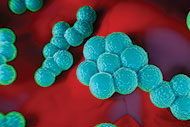 |
|---|
| This initiative is funded by an unrestricted educational grant from Clorox Healthcare™. |
The clinical and environmental services (ES) teams at Geisinger Medical Center in Danville, Pa., have been taking a close look at soft surfaces in the patient care environment in an effort to improve infection-prevention efforts. In particular, privacy curtains have come under scrutiny.
The medical center averages about 130 isolation transfers or discharges per month, notes Jack VanReeth, director of ES and surgical cleaning services.
"What that has meant for us in environmental services is that any time there’s an isolation discharge the cubicle curtains must be taken down, washed and sanitized and a new, clean set of curtains hung," VanReeth says.
It’s a time-consuming, labor-intensive process but one that’s seen as an important safety precaution to prevent the potential spread of multidrug-resistant organisms (MDROs). That’s because studies have shown that privacy curtains often are contaminated with microbes such as vancomycin-resistant Enterococcus (VRE) and methicillin-resistant Staphylococcus aureus (MRSA), which can survive from days to weeks, and others such as Clostridium difficile, which can survive up to months. When caregivers come in contact with the curtains, the pathogens can be passed to their hands or gloves.
William Rutala, Ph.D., M.P.H., director of the hospital epidemiology and occupational health and safety program at University of North Carolina hospitals, says research studies highlight why it is important for ES teams to assess carefully how they clean and treat curtains and other soft surfaces.
"It has been reported that health care personnel (HCP) are less likely to perform hand hygiene after contact with inanimate objects such as curtains than after direct contact with patients, thus the pathogens could travel to patients via the contaminated hands of HCP," Rutala says.
In a recent study at UNC hospitals, Rutala reports that researchers found that the overall level of microbial contamination of privacy curtains was 260.6 colony-forming units (CFUs) per curtain (37 curtains over all were tested), while the level of contamination of privacy curtains with epidemiologically important health care-associated infections (HAIs) — MRSA and VRE — was 12 CFUs per curtain. Post-disinfection the microbial load dropped 96.9 percent. Nearly all of the microbes (97.7 percent) remaining on the curtain after disinfection were Bacillus spp, a spore-forming organism, Rutala notes.
Across the spectrum of soft surfaces in hospitals — from curtains to upholstery to linens to mattresses, HCP clothing and other porous surfaces — ES teams have a difficult challenge ensuring that thorough cleaning has been performed let alone trying to verify disinfection.
Kelly Reynolds, MSPH, Ph.D., associate professor at the Mel & Enid Zuckerman College of Public Health at the University of Arizona, Tucson, says that while there isn’t a wealth of evidence that organisms exist on soft surfaces in the hospital environment one would expect that the same organisms found on hard surfaces eventually would end up on soft surfaces.
"Some of the key pathogens are MRSA and C. difficile. In the studies we have done at the University of Arizona we have been able to isolate MRSA and general S. aureus from soft surfaces," Reynolds says. "One thing we know from other studies outside the hospital is that MRSA in particular is very well-adapted to drying out and surviving on soft surfaces and tends to last longer than Escherichi coli organisms."
A number of studies conducted in the health care environment indicate that soft surfaces can contribute to cross-contamination. Still, Reynolds cautions that no clear evidence has been reported that soft-surface contamination directly causes HAIs.
"We’ve done some studies looking at how easily organisms transfer from soft surfaces to the hand when someone touches that surface. We find that transfer from the soft surface back to the hand definitely occurs," Reynolds says. "It’s not as efficient as with hard surfaces but because most of these organisms have a low infectious-dose, transfer efficiency doesn’t need to be very good to contribute to nosocomial transmission."
This latter point was underscored in a research paper published last year in the American Journal of Infection Control. In it, British researchers Jonathan A. Otter et al. reported on the role contaminated surfaces play in transmission and the various strategies available to address environmental contamination in hospitals. They pointed to several in vitro studies using DNA or other markers, model organisms, or pathogens that showed that transfer can occur from environmental surfaces to hands or vice versa.
This paper also cited several observational epidemiologic studies that established that contaminated surfaces are involved in the transmission of pathogens. And while these studies didn’t specifically address soft surfaces vs. hard surfaces, the conclusions underscore the need for ES teams to be concerned with all areas of surface decontamination.
A 2006 study by Mary G. Lankford, et al. on furniture upholstery, walls and flooring inoculated with VRE and Pseudomonas aeruginosa found that VRE was recovered on all 14 surfaces tested 24 hours after inoculation using impression plates while P. aeruginosa was present on 13 of 14 surfaces. After cleaning, VRE was recovered from seven surfaces and P. aeruginosa was present on five surfaces.
Similar concerns about HCP clothing — including lab coats, footwear and shared equipment — being able to harbor pathogens led the Society for Healthcare Epidemiology of America in January to issue recommendations to prevent the transmission of HAIs. The guidance covered recommended laundering practices, adopting a "bare-below-the-elbows" approach for HCP delivering inpatient care as a supplemental infection-prevention policy and more.
With all of this mounting concern about the potential role soft surfaces can play in harboring epidemiologically significant pathogens, it begs the question: What should ES teams do to address these potential threats to patient and HCP safety?
At Geisinger Medical Center, consideration was given to using disposable curtains, but the clinical care team didn’t find this a suitable option. "Patient care providers were of the opinion that the disposable curtains, which were generally nonporous or close to being nonporous, didn’t provide enough airflow for patients," VanReeth says. He adds that the organization is also working to minimize the amount of soft surfaces in furniture situated in patient care areas.
Rutala notes that all decontamination and infection prevention technologies available for treating soft surfaces have advantages and disadvantages.
"Decontamination by use of a disinfectant which is rapidly acting, has a broad spectrum and low toxicity is one option, Rutala says. "The use of a disinfectant easily could be integrated into health care practices where the occupancy is high and fast patient room turnaround time is critical. This option is an alternative to other options such as laundering privacy curtains between patients."
Reynolds says tests conducted in the field in a real-time application have shown a sanitizing spray reduced general background bacteria by 99 percent. The next phase of testing the product will involve putting microbial tracers on soft surfaces to get a better idea of reduction on the various soft surfaces that have been inoculated with organisms.
"Thus far we have found that the sanitizing spray has been very effective. But I want to issue a word of caution that any sanitizing spray that is chosen for soft surfaces should be EPA-registered for soft-surface sanitizing. That way you can be sure that product has been tested to achieve a 99.9 percent reduction, as required by the EPA," Reynolds says.
Antimicrobial fabrics also have a role to play in reducing the potential for pathogen transfer from soft surfaces, Reynolds says, by keeping germ counts lower in those environments. These fabrics still can become contaminated, she cautions, and should undergo the same cleaning and sanitizing routine as that of other fabrics.
Bob Kehoe is the associate publisher of HFM.
Resources
- Society for Healthcare Epidemiology of America Guidance on Healthcare Personnel Attire
- David J. Weber, M.D., MPH; William A. Rutala, PhD, MPH. “Understanding and Preventing Transmission of Healthcare-Associated Pathogens Due to the Contaminated Hospital Environment”; Infection Control and Hospital Epidemiology, Vol. 34, No. 5 (May 2013), pp. 449–452, The University of Chicago Press on behalf of The Society for Healthcare Epidemiology of America
- Jonathan A. Otter PhD, Saber Yezli PhD, James A.G. Salkeld BSc, Gary L. French M.D., FRC. “Evidence that contaminated surfaces contribute to the transmission of hospital pathogens and an overview of strategies to address contaminated surfaces in hospital settings”; American Journal of Infection Control, 41 (2013) S6-S11





